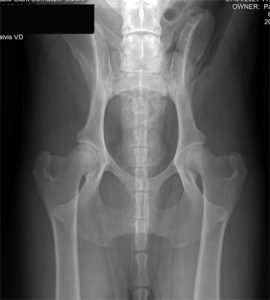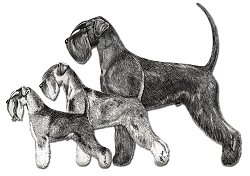 Hip Dysplasia (HD) and the Giant Schnauzer
Hip Dysplasia (HD) and the Giant Schnauzer
- Info
- Health Screening
- Buyer Advice
- Breeder Advice
- How You Can Help
What is Hip Dysplasia (HD)?
Hip dysplasia is the abnormal development of the hip during growth which leads to increased wear and tear and subsequent deformity of the joint. The abnormal joint may become painful and cause lameness due to arthritic or degenerative changes.
Prevalence
Currently more research is required to determine the number of symptomatic affected Giant Schnauzers. Hip score statistics are monitored and breed statistics can be seen on the following link:
Age of Onset
Dogs are not born with hip joints already affected by dysplasia (unlike humans) but that any faults in development will tend to escalate with time, particularly during the rapid growth phase from about 4 to 10 months of age. However, changes begin as the very young puppy starts to become active and continue until the puppy is skeletally mature at around 12-18 months. Once changes begin to occur symptoms may become evident as the joint deteriorates over time: secondary arthritis is progressive throughout life.
Mode of Inheritance
The mode of inheritance is not currently known, however it is thought to be polygenic i.e. produced from the cumulative effects of many genes. In addition to a genetic involvement the environment within which the dog is raised, including the type and intensity of exercise, growth rate and body weight are significant influences. All the essential nutritional requirements for skeletal growth must be available in the right proportions and at the right time.
Signs & Symptoms
As HD can include joint looseness (laxity), inflammation, pain, new bone formation and bone erosion, it may cause a range of observable signs from normal to minor changes in gait (in the mildly affected cases) to obvious lameness, stiffness after rest and exercise intolerance and pain. Often, clinical signs are not evident until the dog is older and past its breeding years.
Diagnosis
Usually a dog with HD does not demonstrate discomfort by yelping, as pain is likely to be dull and continuous rather than sharp and acute. The dog may, though, groan while resting or getting up. A veterinary surgeon’s physical examination is quite limited and radiography is the only means of determining the presence or absence of HD. This is an x-ray examination to look at the relative shape and positions of the femoral head and acetabulum and the presence and degree of any secondary changes.
Prognosis
It is possible to alleviate some or most of the signs of pain and limitation of movement caused by HD. Sophisticated medications and various surgical procedures are now available. Applied heat, massage, good bedding, exercise and weight management as well as nutrition and physiotherapy also play a part in caring for a dog affected by HD. Professional advice is always necessary to ensure that the best strategy is developed.
BVA/KC Hip Dysplasia Scheme
Breeders are recommended to hip score breeding stock.
It is also useful to consider the scores of as many relatives as possible.
 The British Veterinary Association (BVA) and the Kennel Club (KC) developed a scheme some 40 years ago to assess the degree of hip deformity of dogs using x-rays.
The British Veterinary Association (BVA) and the Kennel Club (KC) developed a scheme some 40 years ago to assess the degree of hip deformity of dogs using x-rays.
X-rays submitted to the BVA/KC Hip Dysplasia Scheme are ‘scored’. The hip score is the sum of the points accrued for each of nine radiographic features in each hip joint. The lower the score the less the degree of HD present. The minimum (best) score for each hip is zero and the maximum (worst) is 53, giving a range for the total score of 0 to 106.
Hips are scored once only in the lifetime of the dog.
Where to go for Hip Scoring
Owners should contact their veterinary surgeon and arrange an appointment for their dog to be x-rayed. The x-rays must be taken under anaesthesia or heavy sedation which means that the dog may have to be left for a short time at the veterinary practice.
Requirements for Hip Scoring
- Dogs must be at least 1 year old.
- Dogs must be identified by microchip or tattoo.
- Registration certificate is required for KC registered dogs (non-registered and dogs from abroad can also be screened)
BVA Costs
BVA submission fees can be found on the BVA Canine Health Schemes website
There will also be additional veterinary fees for anaesthesia/sedation and taking of the x-rays, the cost of which may vary.
Publication of Results
The Kennel Club is responsible for publishing the results in the Kennel Club Breed Records Supplement, on progeny registration certificates and on the Kennel Club health results database.
Advice for Puppy Buyers
Ideally choose a breeder where there is a hip score history of the puppy’s parents.
Although hip scoring cannot guarantee a puppy will not develop Hip Dysplasia, knowing the hip scores of parents and ancestors can help reduce the risk of purchasing a puppy that may become affected later.
As a guide, the current breed average over the last 15 years is a total score of 12 and median (middle) score is 10. The lower the score, the better the hips. In addition the way puppies are brought up as they are growing can have an affect on joint development.
As a minimum the breeder should be happy to talk to you about the hips and development from puppy to adult. The breeder should be able to provide information and advice on the amount of exercise, activities to avoid, appropriate nutritional requirements, growth rate and optimum body weight to help prevent a puppy from damaging their joints whilst growing and developing.
Kennel Club Health Test Result Finder
If you know the name of the puppy’s parents you can look up the hip score results and any other recognised KC/BVA health tests via the Kennel Club Health Test Results Finder. You may also ask the breeder to show you any hip score certificates, copies of which should be included in the puppy information pack.
Advice for Breeders
Breeders are recommended to hip score breeding stock.
It is also useful to consider the scores of as many relatives as possible.
The minimum age for hip scoring is one year, and each dog is only ever scored once under the scheme.
An average (or mean) score is calculated for all breeds scored under the scheme, the current 15 year breed mean score for Giant Schnauzers is 12 and median (middle) score is 10.
Selection of dogs for breeding based on hip scores is not an exact science, since environmental as well as genetic factors are involved in determining the nature of the hip joints. However, the best chance of producing offspring with good hips is to use parents with low scores, below the breed mean and ideally below the median.
Useful Reading:
Interpretation and use of BVA/KC hip scores in dogs
by R. Dennis In Practice (2012) 34 178-194
Take part in the Joint Schnauzer Breeds Health Survey
 If you own a dog diagnosed with hip dysplasia, please let us know by taking part in the Joint Schnauzer Breeds Health Surveys and/or contact the Breed Health Co-ordinator.
If you own a dog diagnosed with hip dysplasia, please let us know by taking part in the Joint Schnauzer Breeds Health Surveys and/or contact the Breed Health Co-ordinator.
In this way the incidence of health conditions can be monitored and any emerging problems identified.
Make a Donation to the GSHF
The purpose of the GSHF is to provide monies for research into inherited health problems in the Giant Schnauzer. All donations gratefully received.
